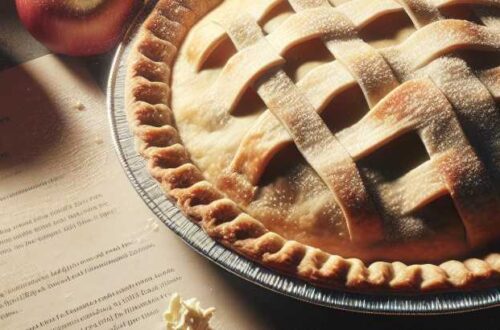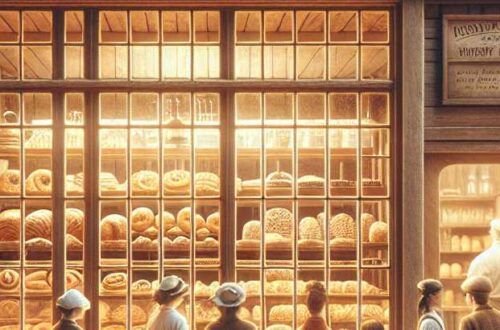The Science of Baking

1. Understanding chemical reactions in baking
Title: The Whisked-Up World of Baking Chemistry: A Rise to the Occasion!”
Ah, baking—where creativity gushes forth in an edible eruption of flavors, aromas, and breathtaking visuals. But behind those sugar-dusted crumpets or towering chocolate cakes lies a mysterious, effervescent world. Drumroll, please! The unsung hero of your baking exploits is – chemical reactions! Yes, that dreaded subject that gave you cold sweats in high school. Fear not, gentle reader, no pop quizzes here, only the delicious science within your favorite pastries. So, put your goggles on (or, apron, if you will), for we’re about to embark on an entertaining and educational journey into the chemistry of baking!
Get ready, there’s going to be plenty of heat, gas, and transformation. Spoiler alert – we’re not making meth, we’re baking!
Baking indeed is not only an art but also an exact science—alchemy, if you may, with a sprinkle of pixie dust (also known as baking powder). It begins when you combine ingredients that may seem to have as much in common as chalk and cheese—like salt and sugar, milk, and vinegar. Yet, when they meet under the hot sun (or oven), chemical reactions spark joy in a bakefest fireworks display, resulting in heavenly aromas and delectable creations.
First off, let’s talk about the most iconic agent of change in the baking business – leavening agents. Leavening agents, such as yeast, baking powder, and baking soda, are the secret sauce to your baked goods’ fluffiness and texture. They produce carbon dioxide gas when heated or combined with other ingredients, leading to an effervescent waltz of bubbles that give your breads, cakes, and cookies their airy charm. Incidentally, they also save you the embarrassment of serving pancakes as dense as a black hole at your weekend brunch.
Next up in this chemistry cabaret is the Maillard Reaction — the Crème de la crème of food chemistry.
“Her faithfulness to her material, her vivid photographs, her devotion to science which little by little crushed out her woman’s heart, her conception of the novel as the record of a dissection–the reactions of human souls under the scalpel and the microscope, her materialism that refused all testimony save that of the test-tube and the known reagents, that reduced man to a problem in psychology–all this made its reflex upon the young student”
~ Unknown, Unknown
This reaction is the dynamic duo dance between reducing sugars and proteins when they meet heat, leading to that tantalizing, golden-brown color and roasty-toasty flavors in your fresh-baked bread. Much like the chameleons of the animal kingdom, the Maillard reaction is a master of disguise– it is the transformation king that turns your dough into bronze-glowing Godly delights!
Let’s not forget about caramelization — the sweet sister of the Maillard reaction. It’s sugar’s solo extravaganza under high heat, resulting in a myriad of flavorful compounds that take your desserts from ‘Oh, nice’ to ‘Heavens, that’s ambrosial!’. That glossy brown sugar-glazed apple tart? Caramelization’s decadent masterpiece!
Finally, we reach the coagulation climax. Remember those jiggly custard tarts or firm quiche? You can send your thank you notes to this process. As the name suggests, coagulation is when proteins in eggs, milk, and flour set under heat, transforming your liquid batter into a firm, sliceable delight. It’s like magic, but with more science and less sawing people in half.
Our stroll down baking chemistry lane might be nearing the finish line, but surely enough, you’re now armed with knowledge beyond ‘preheat oven to 350°’ and ‘combine, mix, bake’. Unseen to the naked eye, dynamic and vivacious chemical reactions craft the very soul of our melty, chewy, fluffy, crispy baked goodies. The next time you chomp down on a delicious slice of banana bread or a buttery croissant, take a moment to salute the scientific spectacle that’s worked its magic in your delightful treat.
So, indulge and experiment. Encounter failures like a flat souffle or a crumbly cookie? Remember, it’s not a baking blunder, but a lovable mishap in the lab of delicious chemistry called your kitchen. Bake on, science warriors!
Learn More: 1. Understanding Chemical Reactions In Baking

2. Role of ingredients in baking science
Title: The Great Baking Symphony: A Delicious Science
Ever had a day where you tried to bake a cake which turned into all sorts of tragedy? You added the eggs, flour, butter, and even the rare fairy dust, also known as sugar, and voila!—A brick. Yep, that’s right, not a cake, but a unapologetic, remorseless brick. You then wonder – what went wrong? The role of ingredients in your baking symphony is like the difference between Beethoven’s Symphony No. 5 and your toddler’s first attempt at the recorder. So, let’s delve into the magical world of baking science.
Let’s start with the maestro of the baking orchestra—flour—a powdery genie that when summoned, brings every dessert to life. Not to get too Shakespearean, but to bake or not to bake lies in the hands of the noble flour. Besides providing structure, its protein content yields gluten when mixed with water and firmly dictates if your cake packs the puff of a thoroughbred racehorse or maintains the grace of a swan on a loaf-of-bread lake.
Next, we have the pixie dust of the culinary world—the sugar. Despite its reputation, sugar is not just the diva of sweetness in this pastry performance. It is both the belle of the flavor ball and the conjurer of fantastic textures. Sugar also stars as the hydration houdini, retaining moisture for days on end, ensuring your cake doesn’t go crumbly faster than a vampire in direct sunlight.
But hold on, what’s a symphony without a bit of drama? Enter, ‘Butter’—the bad boy on the baking block. The truth is, butter’s just misunderstood. It’s the backbone of your baked wonder, contributing to texture, taste, appearance, and its divine aroma. There’s nothing like the scent of butter baking in the oven.
“They carried out the instruction so fully that seven journals besides those of Lewis and Clark themselves, were carefully kept, and in them a record was made of every important, as well as unimportant, discovery, even down to the ingredients of their meals and their doses of medicine”
~ William Denison Lyman, The Columbia River
It’s like getting a warm, cozy hug from a chunky, giant cookie.
On to the unsung heroes—’Baking Soda and Baking Powder’. These two are the wizards behind the curtain. Like eccentric scientists or wonderfully rebellious teenagers, they react and release gas, causing your dough or batter to rise and create that fluffiness that can make a grown baker cry rivers of joy.
Finally, ‘Eggs’ are the duct tape of the baking world. They’re like the best friend who keeps everything together, even when the rest are causing chaos. They give structure, leavening, flavor, and even help in browning.
So, there it is folks. The baking world is a miraculous science where each ingredient plays a role more crucial than the audience might realize. They are like an ensemble cast, everybody has a role to play, without which the show could go disastrously sideways. Next time when you are conjuring up a cake, do give a nod of reverence to the humble ingredients in your recipe, who in perfect harmony create a beautiful baking melody. Now get your apron on, venture forth into your kitchen, and bake a symphony worthy of a standing ovation.
Learn More Here: 2. Role Of Ingredients In Baking Science

3. Science behind different baking techniques
Title: The Epic Saga of Flour, Heat, and Magic: Unraveling the Science behind Different Baking Techniques
Intro
In the mesmerizing world of baking, not all wizards wield wands—some prefer spatulas and whisks. With a sprinkle of this, a dash of that, and a truckload of patience, they engage in a feverish dance with the elements. But behind every culinary masterpiece lies the unsung hero of the culinary world: Science. Yes, believe it or not, baking is an exhilarating romp through the fabulous world of science. Warning: The following journey could lead to rampant cookie binges, pie-a-thons, and an insatiable desire to buy compulsively cute cupcake molds. Reader discretion is advised.
1. Pop Goes the Leavening! The Scintillating Science of Rising Dough
Oh, ye mighty bread, perched atop the kitchen counter – your fluffy, airy beams eliciting sighs of delight (and groans of longing from diet warriors). Every puffy loaf and cupcake is a marvel of chemistry in action, with the primary agent provocateur being the leavening agent.
Yeast, a single-celled hitchhiking organism, thrives on the sugars in your dough. It’s a bit of a party animal, and when it cranks up the music, it produces carbon dioxide and alcohol in a process called fermentation. This causes the dough to rise like a well-inflated beach ball. Not to be forgotten, baking powder and baking soda, the chemical cousins, unleash an effervescent burst of carbon dioxide when teamed up with an acid and a liquid, resulting in a stellar rise.
Behold, the magnificence of gaseous emissions!
2. Prodding Proteins: The Tantalizing Tale of Gluten Formation
Ah, gluten! The reason why your bread isn’t a crumbly mess and your pizza dough pulls apart with such stretchy satisfaction. Ever wonder how it comes to be? Picture this. The flour and water in your dough are like two shy kids at a school dance.
“The pottery of the Bossier folk was of good quality and still had some of the decoration by engraving, incising, and punctating techniques of the earlier period, but increasing amounts of everyday wares were decorated by simple brushing (similar to Plaquemine pottery of eastern and southern Louisiana)”
~ Clarence H. Webb, The Caddo Indians of Louisiana
The water instigates, the flour relents, and together they form gluten – a network of proteins that add structure and elasticity to your baked goods.
However, overmix and you end up with an athletic Hulk version of gluten: tough and chewy. Precise mixing, vital as a secret handshake, determines the fate of your bake, making the difference between delicate, melt-in-your-mouth pastries and their chewy, hard-to-bite counterparts.
In short: handle with care, unless you’re auditioning for the next tough-as-nails action star – of baking.
3. Maillard Meets Caramelization: The Dazzling Drama of Browning
Enter the stage: Zucker, Zucker, baby—it’s all about sugar! And the delicious browning that happens when heat tickles it the right way.
Caramelization is the sugar diva, strutting its stuff when heat breaks down sugars, subliming them into an aromatic medley of compounds that create rich flavors and colors to die for. No drama, just diva!
The more unassuming Maillard reaction is a tango between amino acids and sugars, orchestrated by heat. This not only gives you the ‘brown’ in ‘browned food’ but also the tantalizing aromas wafting from your warm cookies sashaying straight out of the oven.
Conclusion:
So, there you have it. Embark upon this tantalizing traipse through the captivating world of bubbles and browning, proteins and pastries, and you’ll realize that baking isn’t just a process – it’s a performance. And science, the ingenious conductor, guiding each ingredient and technique with a maestro’s precision.
Now, armed with this knowledge (and hopefully a spatula), you’re all set to conjure up your magnum opus in that sacred space we call the kitchen. Embrace the flour power, let the yeast beast loose, and remember – in baking, as in life, it’s all about enjoying the sizzle, not just the steak. Bon appétit!
Like This? Try: 3. Science Behind Different Baking Techniques





